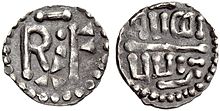Quentovic
Quentovic (formed from Quentia and vicus ) was Münzplatz and the most important medieval port in northern France and from the 7th to 9th centuries, alongside Dorestad in the Netherlands, one of the most important Franconian seaports in the north. Quentovic was also an important stopover on the pilgrimage from England to Rome. It was located in the municipality of La Calotterie in the Pas-de-Calais department .

The place name means "settlement on the Canche ". The Canche ( Latin Quentia) is a small river with a large estuary, about 29.0 kilometers south of Boulogne-sur-Mer .
Historians had long believed that Quentovic was abandoned after the Vikings destroyed the port in 842. The discovery of Fécamp's coin treasure in 1963 refuted the thesis and showed that Quentovic continued to exist as a minting place in the first two thirds of the 10th century. One explanation for the later disappearance of the place is the silting up of the Canche estuary . It's also possible that Montreuil's growth helped spark Quentovic's demise.
The historically transmitted place was searched for for a long time and various places were suggested as locations. In 1985, archaeologists put forward the thesis that the site was near Montreuil. The excavation that was carried out covers a period from the 7th to the 11th centuries and documents large imports. It also documents ceramic production, textile work, glass and metal processing as well as bone and antler processing on site.
In 2009 excavations at the Chemin de Visemarais in La Calotta discovered over a thousand structures from the High Middle Ages on an area of 1.5 hectares . In addition, 30,000 fragments of mammals were found, which allow conclusions to be drawn about the diet of the inhabitants. They ate a lot of beef and goat meat. There was no large-scale fishing. The few fish remains are specimens that have been caught on the coast or in the estuary area.
The “Quentovic Archaeological Museum” in Étaples deals with the Canche estuary from prehistory to the high Middle Ages.
literature
- Stéphane Lebecq, Bruno Béthouart & Laurent Versype: Quentovic. Environnement, archeology, histoire 2006. ISBN 978-2-84467-123-3
Individual evidence
- ↑ Florian Mariage: Les portus de la vallée de l'Escaut à l'époque Carolingienne. Analysis of archéologique et historique des sites de Valenciennes, Tournai, Ename, Gand et Anvers du 9e au 11e siècles. In: E-Thesis. Retrieved November 17, 2012 (French).
- ↑ La Calotterie. (No longer available online.) In: Archéopole. Formerly in the original ; Retrieved November 17, 2012 (French). ( Page no longer available , search in web archives ) Info: The link was automatically marked as defective. Please check the link according to the instructions and then remove this notice.
- ↑ La Calotterie - Quentovic. Exploitation des animaux à Quentovic. UBAAL Unité de Bioarchéologie Animale de Lille, June 19, 2011, accessed on November 17, 2012 (French).
- ↑ Au Rythme des Millénaires .. (No longer available online.) Office de Tourisme d'Étaples, archived from the original on January 15, 2010 ; Retrieved November 17, 2012 (French). Info: The archive link was inserted automatically and has not yet been checked. Please check the original and archive link according to the instructions and then remove this notice.
Coordinates: 50 ° 28 ′ 57 ″ N , 1 ° 43 ′ 17 ″ E

